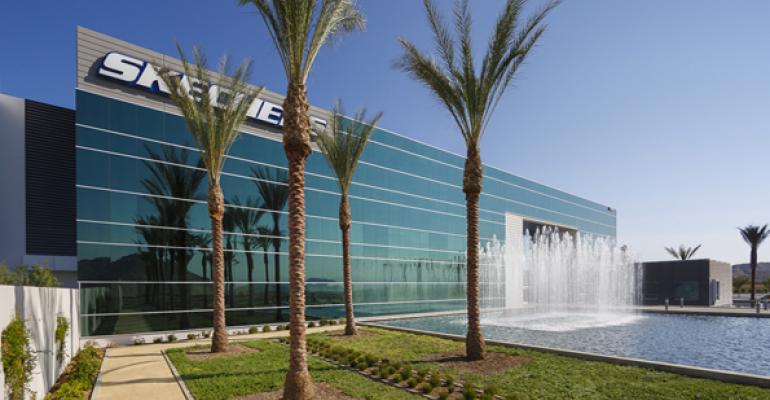The industrial sector, as a whole, with massive expanses of indoor space, has been the last property type to jump fully on to the sustainability bandwagon, in part because professional green certification processes haven’t caught up to the sector’s unique needs.
However, due to tenant and customer demand, more new construction and retrofit industrial projects are gaining professional green certification. According to the U.S. Green Building Council, 117 manufacturing properties have earned LEED certification, totaling 41 million sq. ft. This number should see strong growth, however, as 703 more projects have registered for certification, totaling 221 million sq. ft.
To help focus on green industrial needs, the USGBC formed the LEED Manufacturing User Group in 2012, a collection of firms that include Colgate Palmolive, Intel, Johnson Controls, Siemens and Proctor & Gamble. The group has the goal of finding ways to remove barriers to green certification for industrial properties, and to identify, share and publicize the best-known methods related to the design, operations and maintenance of green manufacturing facilities. It’s also hoped that the industrial sector will have a little more voice at the table after the LEED v4 approval process ends at the end of June. The new standard includes a separate rating for warehouse and distribution centers, where before industrial had been just a subsector of commercial properties. However, a few companies such as Jacksonville, Fla.-based Haskell have blasted USGBC for not making a separate standard for LEED specifically for manufacturing properties. The new LEED version is expected to be officially released this fall.
Distribution facilities are already earning top accolades. Earlier this year, the two-year-old, 1.8-million-sq.-ft. Skechers USA Inc. distribution center in Rancho Belago, Calif., was named the largest building in the United States to receive USGBC’s LEED Gold certification. Up to 20,000 pairs of shoes are processed in an hour at the building, which also has an impressive list of sustainable features, including a white, solar film roof; motion lighting and almost 100 percent of storm water capture and landscaping that reduces irrigation needed by 50 percent.

The point of the project, says Skechers COO/CFO David Weinberg, was to create “a single, environmentally-efficient building that would allow for growth in the coming decade.” But sustainability was also a big concern. "As a global company," adds Weinberg, "we feel it’s our responsibility to protect the environment with green business practices.”
Moreno Valley, Calif.-based Highland Fairview built the facility and owns the building in partnership with Skechers, as part of Skechers’ planned 42-million-sq.-ft. World Logistics Center. Iddo Benzeevi, president of Highland, says there were many other sustainable practices put in place at the shoe center. “We even had a zero dust policy, we would wash down the trucks and equipment before they left the site. With 14,000 concrete trucks, that’s a lot of work,” he says. “But every project we do today we want to be as environmentally friendly as possible, to build to the highest standard.”
Establishing the Skechers North American distribution center into one building, says Weinberg, has allowed the firm “to more efficiently distribute our footwear with reduced energy costs and minimal environmental impact to the surrounding Moreno Valley community.”
Most large corporations today are following customer demands to be environmentally friendly, and that includes even for their manufacturing or distribution facilities, Benzeevi says. Fortunately, as opposed to 20 years ago, green technologies have come down in price, allowing a faster ROI.
Sean Fuller, vice president of business and development with Norwell, Mass.-based Bluestone Energy Services LLC, says a five-year ROI on green technology is common today. “You’re now starting to see more products that provide ROI in three years or less,” he says.
Fuller says it is very difficult for a manufacturing facility, new or existing, to earn the LEED standard. However, he says, incentives offered by communities, organizations and energy providers have been the game-changers needed to allow sustainable features on shop floors. Rebates on energy-efficient retrofits can pick up 30 percent to 50 percent of the costs of the installation, Fuller says.
As an example of successful incentive use, Fuller’s firm recently installed new LED lighting at Mack Technologies’ 108,000-sq.-ft. manufacturing facility in Westford, Mass. The new lighting, he says, will save the company more than $50,000 in annual lighting costs. The project will receive more than $130,000 in a combination of state and federal tax credits and utility incentives provided by National Grid. The project is expected to have an ROI within three years, Fuller says.
“Many firms today are adopting these new technologies to meet company-wide goals of saving 15 percent of energy use by 2015, or 20 percent less water runoff,” Fuller notes. “While people are interested in going green, industrial facility managers want to make sure it’s going to make things more efficient, they want to save money.”

